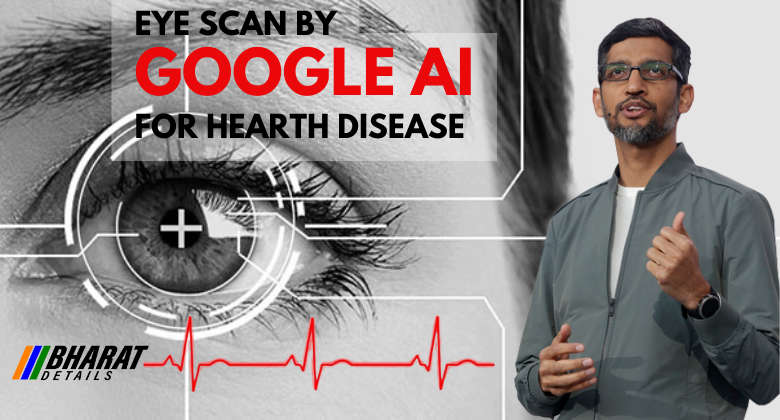Google’s AI Advancement: Predicting Heart Disease via EYE Scans

- Sundar Pichai Unveils Google's Groundbreaking AI Innovation: Rapid Eye Scan to Predict Heart Disease Risk, a Promising Non-invasive Alternative to CT Scans, MRIs, and X-rays.
A Revolutionary Turn in the Health Tech Sector: Sundar Pichai, CEO of Google, Leads the Way with Advanced AI Solutions. Pichai’s Recent Revelation Unveils an Astounding Breakthrough: Google’s AI Empowers Eye Scans to Predict Cardiovascular Events, Potentially Redefining Diagnostic Approaches away from CT Scans, MRIs, and X-rays.
Contents
Unleashing the Potential: Google’s Power in AI-driven Health Tech
“A Transformative Collaboration: Google and Aravind Eye Hospital Revolutionize Diabetic Retinopathy Detection”
Four years ago, a collaborative team of experts from Google and Aravind Eye Hospital embarked on a groundbreaking endeavor. Their goal? To create an automated tool capable of detecting diabetic retinopathy, a prevalent cause of worldwide blindness. Through meticulous research and development, they successfully crafted an algorithm that swiftly recognizes the disease’s indicators, providing a diagnosis within seconds based on retinal photographs. The imminent autonomy of this algorithm promises to reshape the field of eye disease detection and management in the near future.
Beyond expectations, the AI’s prowess extended further. In a recent milestone, Google introduced an algorithm with the remarkable capability to discern an individual’s gender, smoking habits, and forecast their five-year susceptibility to a heart attack, all derived from retinal images. Astonishingly, the AI possessed the capacity to identify issues that eluded its human trainers, unlocking a realm of opportunities for early detection of various conditions, including dementia, multiple sclerosis, Parkinson’s disease, Alzheimer’s, and even schizophrenia. This groundbreaking advancement heralds a new era of possibilities in disease prevention and proactive healthcare.
AI and the Eye: A Window to Cardiovascular Health
The eye, particularly the retina, serves as a gateway to assessing one’s holistic well-being. Within the inner rear wall of the eye, known as the fundus, a complex network of blood vessels exists, mirroring the body’s general state of health. By examining their characteristics, medical professionals can deduce significant details such as blood pressure levels, age indicators, and smoking patterns, all of which play a vital role in predicting cardiovascular wellness.
In their pursuit of developing a cardiovascular prediction algorithm, Google and Verily’s scientific experts leveraged the power of machine learning to meticulously examine an extensive medical dataset encompassing approximately 300,000 patients. This comprehensive collection consisted of both eye scans and general medical information. Through the utilization of neural networks, these datasets were meticulously scrutinized for discernible patterns, enabling the algorithms to establish associations between distinctive indicators observed in the eye scans and the essential metrics required to forecast cardiovascular risk factors, such as age and blood pressure.
During testing, Google’s AI exhibited an impressive ability to differentiate between the retinal images of two patients: one who experienced a cardiovascular event within the subsequent five years and one who remained unaffected. Remarkably, the AI achieved a success rate of 70% in these predictions. This performance was only marginally below the widely employed SCORE method, which relies on a blood test and achieves accurate predictions 72% of the time.
The Future of Health Diagnostics
This groundbreaking approach to evaluating cardiovascular risk not only streamlines and expedites the process for medical practitioners but also signifies a transformative transition towards an AI-driven paradigm in scientific exploration. By harnessing the power of AI algorithms, this method introduces novel avenues for analyzing vast amounts of existing medical data, hinting at the potential for artificial intelligence to autonomously generate unprecedented medical insights without explicit human guidance. This remarkable advancement opens up promising horizons for the future of medical research and innovation.
Moreover, the possibilities of this technology extend far beyond advanced medical institutions. In rural vision centers, where access to specialized equipment may be limited, an affordable and portable solution could revolutionize vision screenings. By utilizing a smartphone, a relatively inexpensive condensing lens, and a do-it-yourself retinal camera, individuals can capture retinal images on the go. These images can then be uploaded to the cloud, enabling swift diagnosis and providing results within moments. This innovative approach showcases the immense potential of the technology in reaching underserved areas and making healthcare more accessible to all.
Although the notion of an AI doctor autonomously generating novel diagnoses may seem like a distant possibility, the research indicates that this idea is not entirely implausible. Sundar Pichai’s recent announcement exemplifies how Google’s AI is already making significant advancements towards a future where conventional diagnostic techniques may take a backseat to the valuable insights obtainable from ocular examinations. Envisioned ahead lies a realm where a swift eye scan has the potential to unveil concealed health concerns and predict impending cardiovascular incidents, leading to a transformative shift in healthcare and diagnostic approaches.
Also read ⬇️
Empowered by Google’s AI, every eye becomes a powerful narrator, illuminating the path towards a healthier future. In this thrilling age of health technology, the saying, “To comprehend the body, gaze into the eyes,” resonates with deeper meaning than ever. The vision of healthcare grows sharper, focused intently on the revelations found within our very own eyes.

